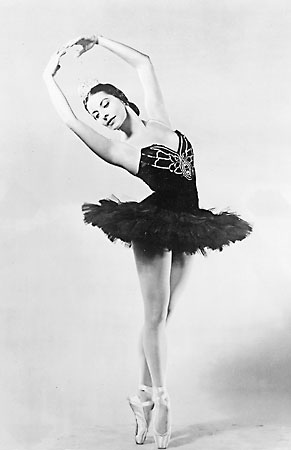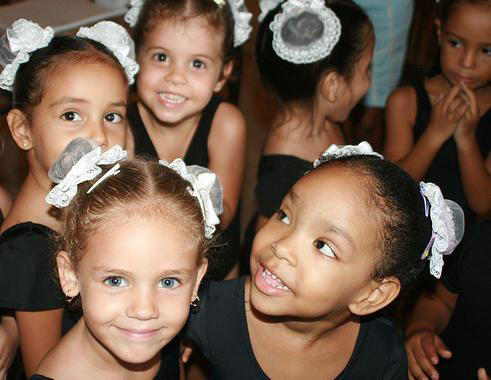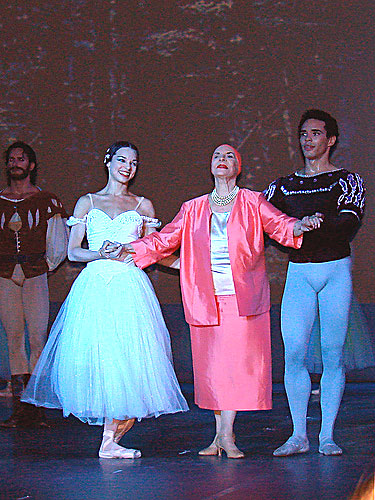|
Alicia Ernestina de la Caridad del Cobre MartĂnez Hoya was born in Havana, Cuba the 21 of December of 1920 as one of two daughters of an army officer and his wife.
Alonso began dancing at a very young age. "When I was little, I'd move around whenever I heard music.. I dreamed of having long hair, so I'd dance around with towels on my head, pretending it was my hair streaming out behind me," she revealed in an interview. Her first dance training occurred during her father's year-long military assignment in Spain. Her Spanish grandfather suggested she learn the local dances, so Alonso studied flamenco and even learned to play the castanets. At eight years old, she returned with her family to Cuba and took her first ballet lesson at the Sociedad Pro-Arte Musical school in Havana. At ten she made her first stage appearance in a production of Sleeping Beauty dancing as Alicia Martinez..
At the age of 16, she married fellow ballet student, Fernando Alonso and the couple moved to New York City.
Alicia began her professional career in Broadway musicals such as "Great Lady" in 1938 and "Stars in Your Eyes" in 1939.
Though already suffering from sight problems, the great ballerina was one of the main stars of the Ballet Caravan and later of the American Ballet Theater. In 1939, she was a soloist with the Ballet Caravan, the antecedent of the current New York City Ballet and in 1940, the year it was established; Alicia joined the American Ballet Theater. As of that moment, a brilliant and successful career began as a top performer of classic and romantic ballets.
After the birth of her daughter Laura, Alicia continued her training at the School of American Ballet and took private classes with Leon Fokine, Alexandra Fedorova, Enrico Zanfretta and Anatole Vilzak and arranged a travel to London to study with the renowned Vera Volkova.
Alicia was afflicted with an eye defect and was partially blind after she turned 19. Soon she had her partners be in the spot she expected them to be. She also used lights in assorted parts of the stage to guide her too. After seeing the doctor for worsening vision problems, Alonso was diagnosed in 1941 with a detached retina. She had surgery to correct the problem and was ordered to lie in bed motionless for three months to allow her eyes to heal. Unable to comply completely, Alonso practiced with her feet alone, pointing and stretching to, as she put it, to "keep my feet alive." When the bandages came off, Alonso was dismayed to find that the operation had not been totally successful. The doctors performed a second surgery, but its failure caused them to conclude that the dancer would never have peripheral vision.
Finally, Alonso consented to a third procedure in Havana, but this time was ordered to lay completely motionless in bed for an entire year. She was not permitted to play with Laura, chew food too hard, laugh or cry, or move her head. Her husband sat with her every day, using their fingers to teach her the great dancing roles of classical ballet. Alonso later recalled of that period, "I danced in my mind. Blinded, motionless, flat on my back, I taught myself to dance Giselle."
Finally, she was allowed to leave her bed, though dancing was out of the question. Instead, she walked with her dogs and, against doctor's orders, went to the ballet studio down the street every day to begin practicing again. Then, just as her hope was returning, Alonso was scraped when a hurricane shattered a door in her home, spraying glass splinters onto her head and face.
Nearly mad with impatience and partially blind, Alonso traveled backwards to New York to found her own company, the Alicia Alonso Ballet Company, which she maintained with little financial support.
Youskevitch and her other partners quickly became expert at helping Alonso conceal her handicap. To compensate for only partial sight in one eye and no peripheral vision, the ballerina trained her partners to be exactly where she needed them without exception. She also had the set designers install brawny spotlights in assorted colors to help as guides for her movements. Alonso knew, for instance, that if she stepped into the glow of the spotlights nearby the front of the stage, she was getting too close to the orchestra pit. There was also a thin wire stretched across the edge of the stage at waist height as another marker for her, but in general she danced within the encircling arms of her partners and was led by them from saucer to point. Audiences were reportedly never the wiser as they watched the prima ballerina.
Alonso's desire to develop ballet in her own state led her to return to Havana in 1948. Fernando was the general director of the company, which was at that instance composed mainly of Ballet Theater dancers temporarily out of contract due to a reorganization of the New York company. Fernando's brother Alberto, a choreographer, served as artistic director for the company.-The company debuted briefly in the capital and then departed for a tour of South America. The performances were a hit with audiences everywhere, but Alonso found herself supporting the company with her savings to keep it going despite donations from wealthy families and a modest subsidy from the Cuban Ministry of Education.
Between 1955 and 1959, Alicia danced every assemblage with the Ballet Russe de Monte Carlo as guest star. She was the first partner of the Western Hemisphere to perform in the Soviet Union, and the first American representative to the Bolshoi and Kirov Theaters of Moscow and Leningrad (St. Petersburg) respectively in 1957 and 1958. She danced as guest artist with the House de Paris, the Royal Danish Ballet, the Bolshoi and with other companies. She staged her versions of Giselle, Pas de Quatre, and Sleeping Beauty for the Paris Opera.- She also staged Giselle at the Vienna State Opera and the San Carlo Theater of Naples, Italy; La Fille MalGardee at the Prague State Opera, and Sleeping Beauty at the Teatro alla Scala in Milan.
 |
In 1958 Alonso was awarded the prestigious annual award from Dance magazine. It was just one of many major awards her dancing would garner. Over the next decade, She performed as a guest artist with companies throughout the world and danced under the top choreographers of the era including George Balanchine and Anges de Mille. Balanchine created Theme and Variations, a ballet just for her and her then-partner, the great dancer Igor Youskevitch. Alonso and Youskevitch were widely considered the Ginger Rogers and Fred Astaire of ballet. Alonso also mounted her own productions during this time, including her famed rendition of Giselle for the Paris Opera. Her amazing performances are even more incredible when viewed in light of her faltering eyesight. Despite the success of her earlier operations, her vision continued to deteriorate. She was determined to keep her handicap from the audience not wanting it to color their perception of her work. "The difficulty was in dancing with partners, knowing where to find them without my eyes on the stage. But the biggest difficulty was always coming off the stage, trying to find the wings and the curtain drops."
After the Cuban Revolution of 1959 and the ascension of Fidel Castro to power, Alonso chose once again to return to her dear Cuba and reopen her ballet company and school. With political and financial support from Castro's government, the Ballet Nacional de Cuba was born. In addition, Alonso put considerable energy in the creation of a national ballet school and training program. Under the communist regime no child was to be denied access to education. Following the Russian style, Alonso and her corps of teachers travelled throughout Cuba to find talented youth and then fund and manage their training. "I go all over the island, to every one of the tiny mountain villages to find children who want to dance. We play music and then choose those who have the best physique and bone structure".
In a recent interview in London with Dr. de la Sierra, reflecting on the revolution, she said President Batista, Cuba's dictator in the 1950s, had asked her to dance in 1959 but she had refused, and that Castro had visited her home to thank her for her support.
"The first thing Castro did was to state everyone should learn to read and write," she said. "We gave courses to peasants to read and write."
"And to dance?" asked Dr. de la Sierra. Ms Alonso replied: "To be honest, we always did that."
She put forward a theory of dance, suggesting it was both the most basic and the most sophisticated art form. "First we had movement, then language, then music, then dance," she said. "But dance is movement. An animal expresses itself in its movement. I have never known a person to talk all evening without movement."
A network of regional dance schools eventually emerged and with it a corps of talented dancers. Manuel Legris, principal dancer with the Paris Opera Ballet, was quoted as saying, "The Cuban school is exceptional. I meet Cuban dancers all the time … and they all have this astonishing technique, allied artistry and style."
 |
Dancers from Alonso's school have also made an indelible mark on international dance competitions. Varna, the most prestigious ballet competition in the world has awarded medals to more Cuban dancers than any other nationality in its thirty-year history. The style that Alonso's protégés embrace was borne out of Alonso's commitment to both technique and artistry. "Technique has progressed so much today, there's a temptation to dance everything the same unless the dancer understands and masters the meaning of style. Dancers must transmit an emotion, or the classics will just become meaningless. In the Ballet of Cuba, we are trying to produce artists who respect the purity of the original work rather than just brilliant technicians."
Despite her international fame, Alonso and her dance company found themselves barred from performing in the United States for nearly two decades. Although having once been the principal ballerina of the American Ballet Theater, Alonso's alignment with Castro prevented her from even being allowed on U.S. soil. Finally, in 1971 the company was invited to embark upon a North American tour. Though she was in her fifties and nearly blind, her performances garnered accolades. "In some respects the physical command is not so certain as it was years ago, but Alonso is now a far better dancer than she was," wrote a reviewer from the New York Times. "The nuances and grace notes that distinguish great classic dancing from the superbly accomplished are now very evident, and her musical phrasing is as individual as ever."
In 1972 Alonso underwent another operation on her sight allowing her to continue performing. She danced throughout the 1970s and 1980s as a guest performer with the most prestigious ballet companies in the world and also with her Ballet Nacional de Cuba. During this time she also divorced Alonso and married Pedro Simon, a writer and lawyer. By the 1990s, Alonso, nearing seventy years of age, was still performing as the principal dancer of the Havana-based ballet, despite the fact that her vision was once again deteriorating. In January of 1990, as part of the celebration of the fiftieth anniversary of the American Ballet Theater, Alonso danced part of Swan Lake at the Metropolitan Opera House. She was the only founding member still dancing and her performance drew a rousing ovation. Though her age was obviously taking a toll on her performance, a reviewer in the New Leader noted that her technique "gave the ballet a glow that was missing from every performance by ABT's young beauties in their spanking new Swan Lake last spring."
A few years later while on tour with the Ballet Nacional de Cuba she decided to finally hang up her ballet slippers and retire from dancing. "I found myself on a tour in Italy with my own creation Farfalia, which means butterfly. I began to think how short the lives of butterflies really are. I was dancing the role of the butterfly then and when I finished my season in Italy I knew that that was it….I didn't program myself to dance anymore. My decision had come to me as softly as that." Though she left performing, she did not leave center stage and continued to choreograph for the company even as her eyesight finally left her. Though often reluctant to speak about her blindness, according to Alicia, it was no obstacle to her work. . "I put it in my mind. I listen to the music, then I explain it to my wonderful maitres des ballets."
In 1998 Alonso received Cuba's highest civil decoration, the title of "Heroine of Labour of the Republic of Cuba." It was a great honor for a woman who had remained committed to her country through adversity even as artists of all ranks were fleeing. Then in 2002 she was named honorary Ambassador on the occasion of her 70th anniversary of dancing. She deferred this honor to her country saying, "this magical island, despite its small size has made and continues to make great history as an example of culture, valor, and heroism."
 |
On the international front, ballets around the world continue to be inspired by her work. In 2001 the Ballet Nacional de Cuba launched a production entitled La Magia de Alonso which toured extensively to rave reviews. In one of her oft-repeated sentiments, Alonso toldArt Beat, "Dance to me is life itself." It is a life she has lived long and well, leaving a legacy not only for the Cuban dancers that will dance in her footsteps, but for millions of fans worldwide. She summed up her career. "I have lived well. I have achieved a lot. I am aware that I have made history. I planted a seed which grew into a tree and the fruits have been exported all over the world…. Art is the lungs of the people.".
A few days ago, she celebrated her 90th birthday, proclaiming, she would become 200 years old. Being asked what plans she had for retirement, she responded: "I will wait until I get to 100."
To Alicia Alonso, the important thing in life is, that people continued to be creative and do things "that make them alive".
"I love life. I love dancing. I am dance.I wish I could speak every language in the world because I love to communicate. I hate machines. We are the masters of the world, not machines. We are going to forget what it means to be alive, so that when we think of a human, we will think of a machine. We must not!"
|



